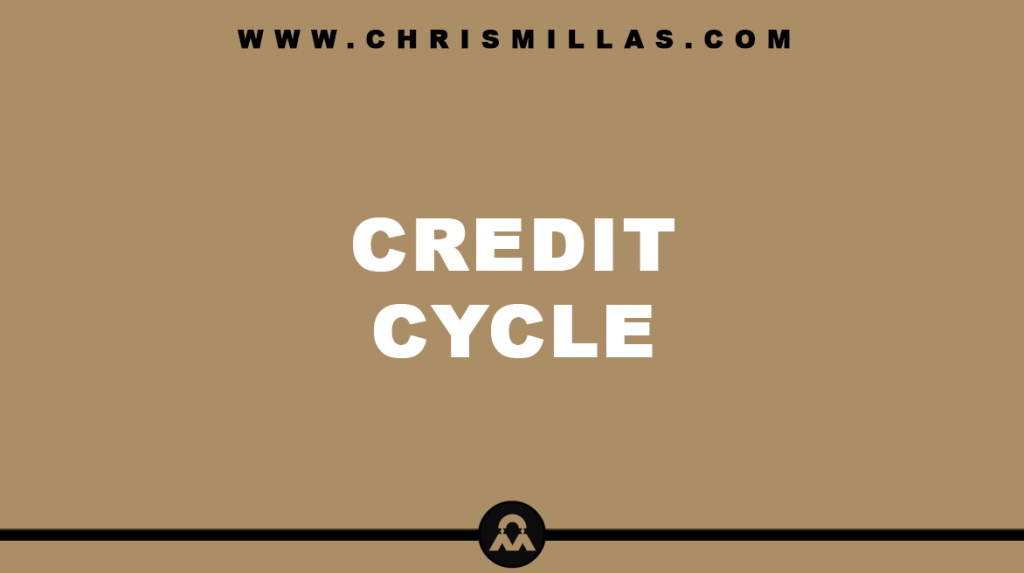In this post, we’ll unpack all you need to know about the credit cycle, defining exactly what it is, what factors drive it, how it impacts asset classes, how to leverage it and more.
What Is The Credit Cycle?
The credit cycle refers to the recurring pattern of expansion and contraction of credit in an economy. It is one of the major cycles in any modern economy.
The 4 Stages Of The Credit Cycle
The credit cycle is characterized by four distinct stages.
The first stage is expansion, where credit and borrowing increases. The second stage is the peak, where credit and borrowing reaches its maximum. The third stage is contraction, where credit and borrowing decreases. The fourth stage is the trough, where credit and borrowing reaches its minimum marking the bottom of the cycle before a new expansion begins and the cycle starts again.
Below is a table summarising the four stages and the credit cycle and their respective characteristics.
| Credit Cycle Stage | Characteristics |
|---|---|
| Expansion | Credit and borrowing increases. |
| Peak | Credit and borrowing reaches its maximum |
| Contraction | Credit and borrowing decreases. |
| Trough | Credit and borrowing reaches its minimum |
What Are The Drivers Of The Credit Cycle?
There are several factors that drive the ebbs and flows of the credit cycle. These include central bank policies such as interest rate adjustments and reserve requirements and economic indicators such as GDP growth and employment levels which influence business and consumer confidence, which in turn impacts borrowing and lending behaviours.
What Are Credit Indicators?
Credit indicators are metrics and data points that give insights into the health and stage of the credit cycle.
Key indicators include credit spreads which represent the yield difference between risk-free bonds and riskier bonds, levels of business and consumer debt and default rates or delinquencies. Monitoring these indicators can therefore provide early warning signs of potential shifts in the credit cycle.
How Does It Impact Asset Classes?
The credit cycle has profound effects on various asset classes.
During expansion phases, real estate equities tend to outperform due to increased consumer spending and business investment. During contractions, bonds, especially government or high-quality corporate bonds, to to outperform as investors seek safety.
How To Leverage The Credit Cycle
Investors can employ several strategies to navigate the credit cycle effectively.
During expansion stages, investors may adopt an aggressive strategy with a higher allocation to equities to maximize returns from a buoyant market. In peak stages, investors may adopt a diversification strategy with a mix of asset classes and hedging instruments to protect gains. During contraction stages, investors may adopt a defensive strategy with a higher allocation to bonds or cash to minimise losses. In trough stages, investors may adopt a recovery strategy with a higher allocation to equities to capitalise on potential market rebounds.
Ultimately, it is wise to remain flexible and adjust asset allocations in response to changing credit conditions.
Below is a table summarising the four stages and the credit cycle and the suggested investment strategy.
| Credit Cycle Stage | Investment Strategy |
|---|---|
| Expansion | Aggressive strategy with a higher allocation to equities |
| Peak | Diversification and hedging strategy to protect gains |
| Contraction | Defensive strategy with a higher allocation to bonds or cash. |
| Trough | Recovery strategy with a higher allocation to risk assets. |
Summary (TL;DR)
The credit cycle depicts the recurring pattern of expansion and contraction of credit in an economy. It is characterised by four stages; expansion, peak, contraction and trough.
The cycle is driven by a number of factors, including interest rates, economic growth and consumer and business confidence.
By understanding the phenomenon and its different stages, monitoring credit indicators and employing strategic asset allocations, investors can harness it to their advantage by making more informed investing decisions to maximise returns and minimise risks.







